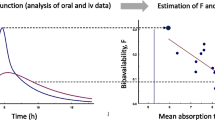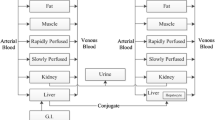Abstract
A dispersion model of hepatic elimination is presented to describe metabolite formation and elimination kinetics within the liver, consistent with the known physiology and biochemistry of this organ. The model is based on the spread in residence times of blood flowing through the liver. This dispersion model is shown to be more consistent with transient and steady-state data obtained after the single passage of phenacetin and acetaminophen through the liver (both normal and retrograde perfusions) than other models of hepatic elimination. The dispersion model is suitable for the evaluation of enzyme heterogeneity using experimentally obtained metabolite data.
Similar content being viewed by others
References
D. L. Miller, C. S. Zanolli, and J. J. Gumucio. Quantitative morphology of the sinusoids of the hepatic acinus. Quantimet analysis of rat liver.Gastroenterology 76:965–969 (1979).
A. M. Rappaport and D. L. J. Bilbey. Segmentation of the liver at the microscopic level.Anat. Rec. 136:262–263 (1960).
J. J. Gumucio and D. L. Miller. Functional implications of liver cell heterogeneity.Gastroenterology 80:393–403 (1981).
K. S. Pang and J. R. Gillette. Kinetics of metabolite formation and elimination in the perfused rat liver preparation: Differences between the elimination of preformed acetaminophen and acetaminophen formed from phenacetin.J. Pharmacol. Exp. Ther. 207:178–194 (1978).
L. Bass. On the location of cellular functions in perfused organs.J. Theor. Biol. 82:347–351 (1980).
L. Bass. Functional zones in rat liver: The degree of overlap.J. Theor. Biol,84:303–319 (1981).
M. Rowland, L. Z. Benet, and G. G. Graham. Clearance concepts in pharmacokinetics.J. Pharmacokin. Biopharm. 1:123–136 (1973).
K. Winkler, S. Keiding, and N. Tygstrup. Clearance as a quantitative measure of liver function. In P. Paumgartner and R. Presig (eds.),The Liver: Quantitative Aspects of Structure and Function, Karger, Basel, 1973, pp. 144–155.
M. S. Roberts and M. Rowland. A dispersion model of hepatic elimination: 1. Formulation of the model and bolus considerations.J. Pharmacokin. Biopharm. 14:227–260 (1986).
M. S. Roberts and M. Rowland. A dispersion model of hepatic elimination: 2. Steady-state considerations-Influence of hepatic blood flow rate, binding within blood, and hepatocellular enzyme activity.J. Pharmacokin. Biopharm. 14:261–268 (1986).
C. A. Goresky. A linear method for determining liver sinusoidal and extravascular volumes.Am. J. Physiol. 204:626–640 (1963).
A. J. Koo, Y. S. Liang, and K. K. Cheng. The terminal microcirculation in the rat.Q. J. Exp. Physiol. 60:261–266 (1975).
O. Levenspiel.Chemical Reaction Engineering, Wiley, New York, 1972, pp. 253–315.
J. C. Mecklenburgh and S. Hartland.Theory of Backmixing. The Design of Continuous Flow Chemical Plant with Backmixing, Wiley, London, 1975, pp. 213–215.
K. S. Pang and M. Rowland. Hepatic clearance of drugs. I. Theoretical considerations of a “well-stirred” model and a “parallel-tube” model. Influence of hepatic blood flow, plasma and blood cell binding and hepatocellular enzymatic activity on hepatic clearance.J. Pharmacokin. Biopharm. 5:625–653 (1977).
P. V. Dankwerts. Continuous flow systems. Distribution of residence times.Chem. Eng. Sci. 2:1–13 (1953).
P. Veng-Pederson. Curve fitting and modelling in pharmacokinetics and some practical experience with NONLIN and a new program FUNFIT.J. Pharmacokin. Biopharm. 5:513–531 (1977).
P. D. I. Richardson and P. G. Withrington. Liver blood flow II. Effects of drugs and hormones on liver blood flow.Gastroenterology 81:356–375 (1981).
K. S. Pang and J. A. Terrell. Retrograde perfusion to probe the heterogeneous distribution of hepatic drug metabolizing enzymes in rats.J. Pharmacol. Exp. Ther. 216:339–346 (1981).
K. S. Pang and M. Rowland. Hepatic clearance of drugs. III. Additional experimental evidence supporting the “well-stirred” model, using metabolite (MEGX) generated from lidocaine under varying hepatic blood flow rates and linear conditions in the perfused liverin situ preparation.J. Pharmacokin. Biopharm. 5:681–699 (1977).
K. S. Pang. Ph.D. Thesis, University of California, 1976.
M. S. Roberts and M. Rowland. Hepatic elimination-Dispersion model.J. Pharm. Sci. 74:585–587 (1985).
Author information
Authors and Affiliations
Rights and permissions
About this article
Cite this article
Roberts, M.S., Rowland, M. A dispersion model of hepatic elimination: 3. Application to metabolite formation and elimination kinetics. Journal of Pharmacokinetics and Biopharmaceutics 14, 289–308 (1986). https://doi.org/10.1007/BF01106708
Received:
Revised:
Published:
Issue Date:
DOI: https://doi.org/10.1007/BF01106708




